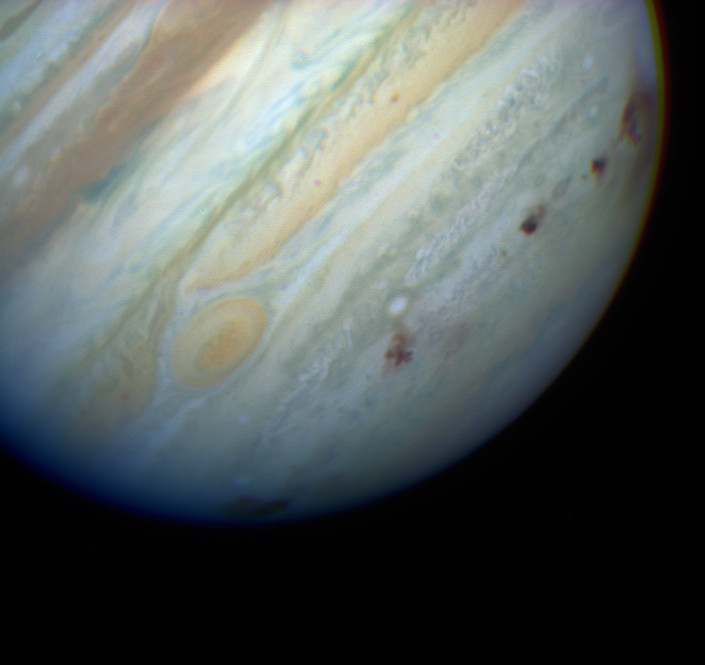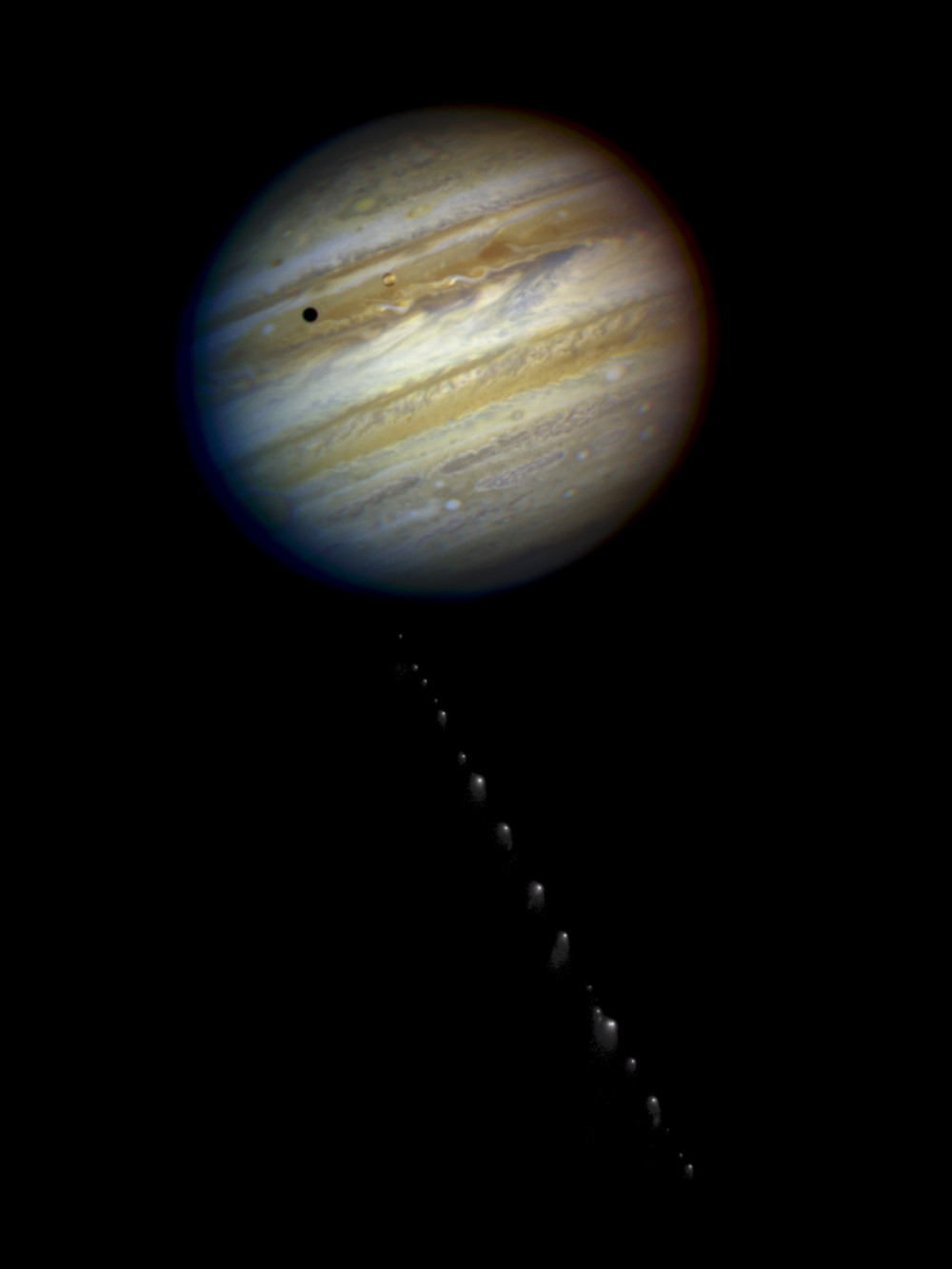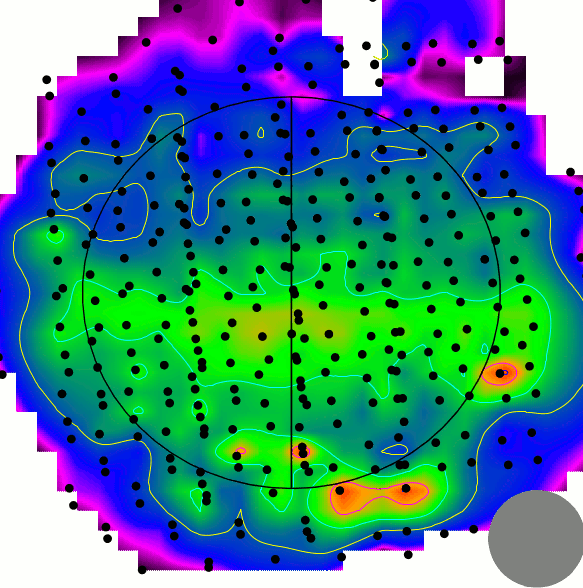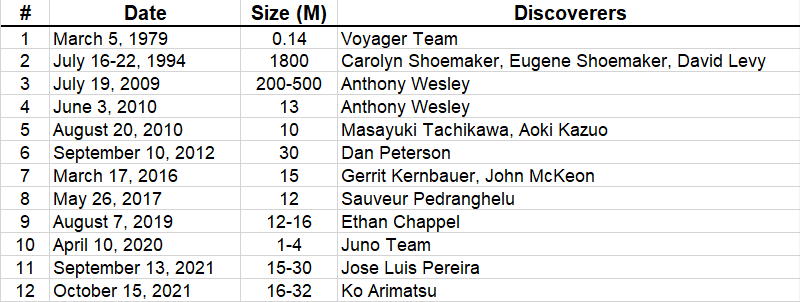
Comet Shoemaker-Levy 9 hits Jupiter
Twenty-eight years ago, between July 16 and 22, 1994, many earthly observers looked on as Comet Shoemaker-Levy 9 (SL9) struck the giant planet Jupiter. Astronomers saw the comet leave visible scars that lingered for months on Jupiter’s cloudtops. This spectacular event was the first real-time observation of an extraterrestrial collision in our solar system. People around the world followed it. Scientists later learned that the comet supplied water to Jupiter’s atmosphere. According to recent studies, the water is still there today.
Astronomers Carolyn Shoemaker, her husband Eugene Shoemaker, and David Levy discovered SL9 orbiting Jupiter on March 24, 1993. It was the first comet observed orbiting a planet rather than the sun. Orbital studies showed that the comet passed within Jupiter’s Roche limit in July 1992. The planet’s tidal forces pulled the comet apart into (at least) 21 fragments.
Astronomers soon learned that SL9’s orbit would pass within Jupiter in July 1994. Then, the comet would collide with the giant planet near 44° south latitude.
And so it did. What a spectacular event!

Water from Shoemaker-Levy 9
Astronomers observed the SL9 impact and its subsequent scars on Jupiter for weeks. But SL9’s chemical impact on Jupiter’s atmosphere lasted much longer. Comets are icy bodies. And scientists observed emission from water vapor during the fireball phase of the SL9 impacts. Later, in 1997, the ESA Infrared Space Observatory detected water vapor in the stratosphere of Jupiter. At that time, because comets do tend to be water-rich bodies, astronomers suspected that it might be a consequence of the SL9 impact.
But there were other possible sources of the observed water: for example, interplanetary dust particles produced by cometary activity and asteroid collisions, icy rings, or one of the 79 Jovian satellites.
Then, in 2013, Thibault Cavalié and his colleagues observed Jupiter with the ESA Herschel Space Observatory, which is sensitive enough to map the abundance of water versus latitude and altitude in the Jovian stratosphere. These observations, which they published in the peer-reviewed journal Astronomy and Astrophysics, showed more water in the south, especially near 44° south latitude, where the comet fragments had hit.
These results indicated that 95% of the water they’d observed on Jupiter came from the comet.
It’s been quite a few years since that first study. But the water is still there. A second study from 2019 and published in 2020 shows that the abundance of water still resides on Jupiter as a result of the Comet Shoemaker-Levy 9 collision.

Impacts on Jupiter continue
Today, we know that impacts continue to occur on Jupiter from time to time, but nothing as large as the SL9 event.
A March 5, 1979, event was one of two seen from a space probe. The Voyager team had observed it on the night side of the planet; it appeared as a brief flash. A very small object caused the 1979 event. It’s thought to have been only 24 pounds (11 kg) and only 5.5 inches (0.14 meter) in size.
A July 19, 2009, event is the only impact beside Shoemaker-Levy 9 that left a scar in Jupiter’s clouds. In this instance no one saw a flash or the impact. The impact might have occurred on the back side of Jupiter. Witnesses only saw the dark gash as a result of an impacting object.
The Juno spacecraft team noted an impact of a small object on April 10, 2020, on the nighttime side of Jupiter. The team estimated the object was 3 to 13 feet (1 to 4 meters) in diameter.
Amateur astronomers discovered the remaining impacts. Each appeared as a short-duration flash, lasting 1 to 4 seconds. Only one, the 2012 impact, was observed visually. The remainder were captured with astro-imaging.

How to observe impacts
So, you might be asking yourself: How did they catch these impacts? Can I accomplish the same feat?
Amateur astronomers who catch impacts on Jupiter do so by imaging – or recording video of – the planet through a telescope. Telescopes used to accomplish this capture so far have had apertures of 4 inches (12 cm) through 15 inches (37 cm), with a median of about 8 inches (20 cm). The number of frames per second is from 15 through 90. So how do these amateur astronomers scan each of these frames?
Most don’t. They are gathering these images so that a software program can remove the blurry ones (the blurriness caused by turbulence in our atmosphere) from the good ones. Then they stack the good ones to produce a beautiful image of Jupiter.
So quite often they have missed impacts. But if they know when the impact occurred, they can go back through their images and find it.
Nowadays, there is some software that will look through the thousands of images for the impact flashes. You can learn more from the users of the software here.
Impacts throughout the solar system
Craters are also occasionally formed on our neighboring planet Mars. But any impacts bright enough to be visible from Earth would be rare, perhaps one every 80 years. Some amateur astronomers also monitor Saturn. But so far, they haven’t seen any flashes. Any planet flashes you are likely to see will likely be on Jupiter.
Comets and asteroids hit Jupiter more than your average planet. It is larger than any other planet and has a larger surface area, but the main culprit is that it has massive gravity. It’s also located in a part of the solar system where asteroids and comets travel slowly. This gives Jupiter time to bring them in for a hard landing.
You might be thinking that with an automated telescope you can image Jupiter for thousands of hours per year. But that’s not as easy as it would seem. If imaging can take place only when your sky is dark, and when Jupiter is at least 20 degrees above your horizon, and the sky is clear and the air is steady, then we’re imaging Jupiter only about 10% to 15% of the time. This amounts to no more than 1,000 hours per year.
Nevertheless, it takes only 5 seconds to record an impact. So go for it!
Bottom line: The impact of Comet Shoemaker-Levy 9 into Jupiter in July 1994 has left a lasting impression. Asteroids and comets continue to hit Jupiter, the largest planet in our solar system.
The post Shoemaker-Levy 9 impact on Jupiter 28 years ago first appeared on EarthSky.
0 Commentaires